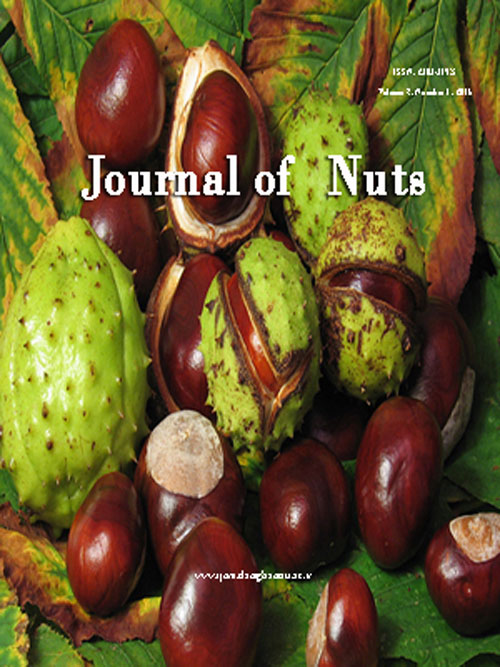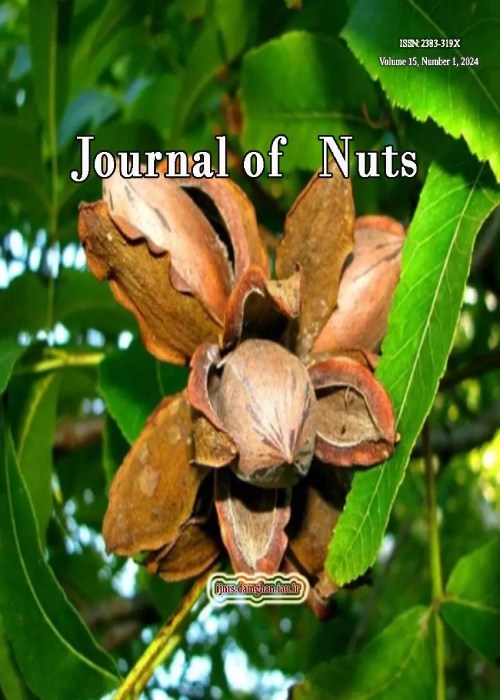فهرست مطالب

Journal of Nuts
Volume:11 Issue: 1, Winter 2020
- تاریخ انتشار: 1399/04/09
- تعداد عناوین: 8
-
-
Pages 1-12
This study was carried out to evaluate the effect of soil application of humic acid on growth and physiological indices of pistachio seedlings ("Badami Zarand" rootstock) under drought stress. This experiment was arranged as a completely randomized design with three replications in greenhouse conditions. The experimental treatments consisted of humic acid (0, 30 and 60 gr in 4 kg-1 soil in pot) and irrigation intervals (7, 20 and 30 days). The studied growth parameters included of stem height, leaf number, leaf area, stem diameter, biomass of root and shoot and physiological indices in leaves such as relative water content (RWC), relative water loss (RWL), leaf water content (LWC), excised leaf water retention (ELWR), excised leaf water loss (ELWL) and relative water protection (RWP). In this experiment, the results showed that relative water content reduced and relative water loss increased in leaf in irrigation interval of 30 days. The results indicated that the application of humic acid increased the vegetative growth of pistachio seedling in comparison with the control under high irrigation interval (p<0.05). The results also showed that relative water content and relative water protection significantly increased with the application of humic acid (p<0.05). These results indicated that the pistachio seedlings were sensitive to water stress and the application of humic acid under drought stress could be an appropriate management strategy to improve the growth of seedlings in pistachio orchards in arid and semi-arid areas of Iran.
Keywords: Drought stress, Humic acid, physiological indices, Pistachio seedling -
Pages 13-22
Population density of Aspergillus section Flavi in pistachio kernels of Iranian cultivars was studied in main pistachio growing areas of Iran during 2015 to 2017. In order to investigate the rate of contamination of pistachio cultivars to Aspergillus section Flavi and aflatoxins, 13 pistachio cultivars, including Akbari, Kaleh-ghouchi, Ovhadi, Ahmad-aghaee, Momtaz, Italian pistachio, Shahpasand, Pesteh-e-ghermes, Pesteh-e-garmeh, Ghazvini, Abbasali and Khanjari were selected from different parts of Semnan, Khorosan Razavi and Kerman provinces. A total of 125 samples of pistachio kernels were collected from different cultivars of pistachio trees in orchards. The samples were cultured on AFPA using serial dilution method. After 3 to 7 days, the plates were examined and isolates of Aspergillus section Flavi were identified and relative densities of them were recorded. The values ranged from 1.6×103 to 1.6×104 CFU/g in pistachio samples.The statistical analysis showed that the population density of Aspergillus section Flavi was varied with the type of cultivars. The results indicated that among tested cultivars, Akbari showed the least and Shahpasand the most population density of Aspergillus section Flavi among pistachio cultivars, respectively. The aflatoxins content of pistachio samples were extracted and analysed through Thin Layer Chromatography (TLC) and flurodensitometer. There were Significant differences among different cultivars in the contamination of pistachio kernels to Aspergillus section Flavi and aflatoxin. (α =5%). It was observed that Akbari had the least whereas Shahpasand had the greatest amount of aflatoxin production, respectively.
Keywords: Aflatoxin, Aspergillus section Flavi, cultivar, Iran, Pistachio -
Pages 23-36In this paper, the effect of infrared (IR) roasting conditions on Aflatoxins and total counts of two types of Iranian pistachio kernels, long and round, was studied. The optimized roasting conditions, 70 V for round pistachios and 90 V for long pistachios with 10 cm distance from IR source were used. Naturally Aflatoxin-contaminated kernels were supplied and roasted. Microbiological and Aflatoxins tests were done before and after roasting, and the results were analyzed by t-test at 5% confidence level. It was shown that 64.00% of total Aflatoxins and 63.99% of Aflatoxin B1 were reduced in long roasted pistachio nut kernels after IR-roasting. However, the reduction levels were 71.40% and 64.94% for total Aflatoxins and Aflatoxin B1 in round pistachio kernels, respectively. Total counts reduction was 99.99% in the round and 99.97% in the long pistachio kernels. In addition, mold and yeast numbers were reduced 99.99% in the round and 99.97% in the long pistachio kernels. Considering mild conditions (90°C and 11.5 min) in IR-roasting process, considerable amounts of reduction in bacteria, mold, and yeast, and the most important reduction of Aflatoxins. This research has shown that IR-roasting process can be considered as an effective method for pistachio nut roasting in Aflatoxin contamination reduction.Keywords: Aflatoxin, infrared, microbial contamination, Pistachio kernel, Roasting
-
Pages 37-46The black walnut (Juglans nigra L.) is an underutilized fruit in the mid-hills of Nepal. However, the physico-chemical properties of Nepalese black walnut are almost unavailable in the literature. Four walnut growing districts namely Baitadi, Dadeldhura, Jumla and East Rukum selected and the black walnut collected at commercial maturity from the local markets. The physical properties were assessed following the IPGRI descriptors, whilst chemical composition by the proximate method across the location. The energy content estimated from the fat, protein and carbohydrate values obtained from the proximate content. The nut weight, kernel weight, nut length, nut diameter were found significantly affected by site, while the effect was similar for the kernel ratio (19-23%). A strong positive correlation (r2 = 0.58) was found between moisture and nut diameter, between moisture and nut weight (r2 = 0.52) and between nut weight and kernel weight (r2 = 0.64). The moisture content, crude protein and total ash content were unaffected by site, whilst the crude fibre, crude fat and soluble carbohydrate content were differed by location of sample collection. The proximate revealed the very best fat or oil content in Dadeldhura district (53.05%), the highest crude fibre in East Rukum district (7.26%), whilst the carbohydrate was found highest in the Jumla (24.69%). The low carbohydrate content in walnut of Dadeldhura might be a hint for the drought tolerance genotype of black walnut. It’s still early to conclude the location effect on black walnut quality without a detailed analysis of environmental and genotypic studies.Keywords: Black walnut, Mid-hills, Nut characteristics, proximate composition
-
Pages 47-62Short growing season restricts production of standard-sized fruit trees in nurseries at cold regions. Enhancing plant growth by optimizing program of mineral nutrition may solve the problem. This study evaluated efficiency of fertilizers [urea, sulfur coated urea (SCU), or foliar applications of a NPK compound fertilizer] for optimizing the growth of seedling rootstocks and grafted young almond trees at the nursery in a cold region. At the end of the first growing season, the growth and quality of the almond seedlings were evaluated and they were budded in September. At the following season, the treatments were repeated on the grafted trees and grafting success and performance of the young almond trees were evaluated. The result showed that application of 600 kg ha-1 SCU and urea were the most successful treatments on enhancing the growth of the seedlings. Application of 400 and 600 kg ha-1 urea and SCU, and 30 kg ha-1 NPK resulted in the highest grafting success at the second season. The largest shoots of scion were found in the 400-600 kg ha-1 urea and SCU treatments. The highest leaf greenness and chlorophyll concentration were found in the 600 kg SCU ha-1 and 30 kg ha-1 NPK treatments. The highest leaf potassium and phosphorus concentrations were found in 30 kg ha-1 NPK treatment. The highest leaf nitrogen concentration was detected in treated plants with 400 and 600 kg SCU and 600 kg urea per hectare. According to the results, application of 400 kg ha-1 SCU is recommended to obtain young standard-sized almond plants in the nurseries.Keywords: Callus quality, Chlorophyll, fertilizers, Graft success, leaf area, Prunus dulcis Mill., Standard tree
-
Pages 63-72This study evaluated the effect of artificial pollination on pistachio trees in an orchard at a low ratio of male to female trees in Qazvin province, Iran, over the years 2012-2013. Experimental factors included three female cultivars (Akbari, Owhadi, Kalebozi) and three types of pollinizer (Control, GA, and GB) with three replications. In each female tree, two branches were selected in the northern and southern directions and bagged before flowering. When stigma was ready to receive pollen, artificial pollination was carried out using the male genotypes GA and GB. The traits of some fertilized flowers per cluster, initial and secondary abscission of flowers and fruits, number of fruits per cluster, nut dry weight per cluster, nut dimension, blankness percentage, and non-split nuts percentage were investigated. The results indicated that artificial pollination in three stages after flowering not only increased the quantitative traits such as number of flowers and fruits per cluster but also reduced the percentage of non-split fruits and blank fruits in all cultivars. The highest and lowest numbers of fertilized flowers were obtained by pollination with GA (91.67) and open pollination (73.89), respectively. Besides, the lowest and highest percentages of initial and secondary abscission of flowers belonged to pollination by GA (13.11-21.44 %) and open pollination (18.33-42.11%), respectively. In addition, the highest initial (54.44) and final (27.66) fruit sets per cluster, the lowest blank nuts (18.01%), and non-split nuts (17.62%) were achieved using pollination with GA. Therefore, it can be concluded that GA is the best male tree for pollination. Akbari cultivar showed the highest nut dry weight per cluster (34.81 g) and the lowest (14.53%) percentage of blank nuts.Keywords: cultivar, Kernel, Nut, Pollinizer, stigma
-
Pages 73-90In this research, twenty-two selected almond hybrids with their parents ‘A1-99’ (drought-sensitive) and ‘Tuono’ (relatively tolerant against drought), were investigated for screening drought tolerance using some morphological and physiological traits. This research was carried out in a complete randomized design with three replications at the Temperate Fruit Research Center of Horticultural Sciences Research Institute (HSRI) in years of 2014 and 2015. The results showed that by applying severe drought stress (30% FC), some morphological and physiological characteristics such as chlorophyll index (ChI), relative water content (RWC) of leaf decreased, while electrolyte leakage (EL) and Quantum efficiency of the photosystem II (Fv/Fm) increased. According to results, there were significant differences among genotypes, for example range of Fv/Fm among the selected hybrids varied from 550 to 879. Frequency of drought tolerance showed that 77. 27% of hybrids were susceptible to relatively susceptible and 22.72% were tolerant to relatively tolerant. Finally, according to the results from this study, ‘DT19’ hybrid was recognized as the most sensitive and ‘DT1’ hybrid was known as the most tolerant hybrid that could be introduced as promising and tolerant to drought stress for utilizing in the breeding programs.Keywords: Chlorophyll fluorescence, Electrolyte leakage, Leaf relative water content, Prunus dulcis Mill
-
Pages 91-99Aflatoxins are secondary metabolites that produced mainly by Aspergillus species in pistachio nuts or other food products. They are toxic carcinogens and mutagens that cause a variety of adverse effects such as acute and chronic poisoning, inducing cancer initiation and congenital malformation in humans and animals. This study aimed to determine level of knowledge, attitude, and practices concerning aflatoxin contamination in pistachio and its pathogenicity among members of the general public in Damghan city, Iran. This descriptive cross sectional study enrolled 297 people from the population of Damghan city in Iran in 2019 through multistage cluster sampling. Data analysis was performed by SPSS version 16. In this study, 57% (n=162) of the participants were male and the mean age was 41.81±12.1 year. Majority (40.7%) of study subjects had very poor level of knowledge, but a positive attitude (68.7%) about the aflatoxin toxicity. Also, more than 85% of study participants sometimes or always had a good practice regarding prevention of aflatoxin contamination. A significant positive correlation was found between the level of education and the knowledge and attitude scores of the participants (p <0.001). Age and practice of subjects had a significant correlation (r = 0.149, p = 0.021). The findings of this study indicate a poor knowledge level of people in Damghan city. Therefore, strategies such as providing necessary training program in order to improve the level of knowledge, attitude and practices of individuals about aflatoxin should be considered.Keywords: Aflatoxin, Attitude, knowledge, Pistachio, Practice


